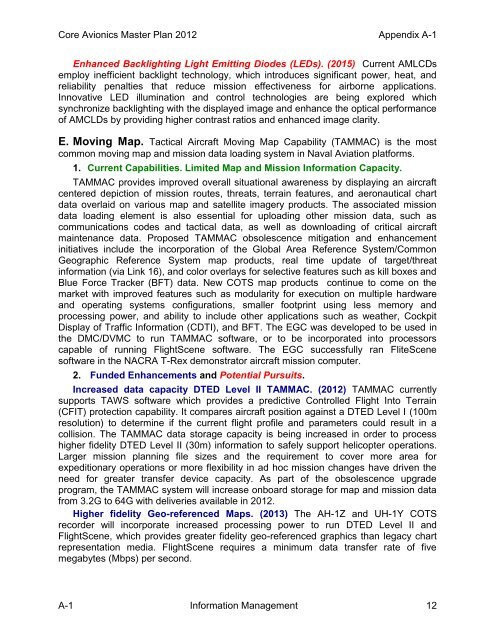PMA209 2012 Core Avionics Master Plan - NAVAIR - U.S. Navy
PMA209 2012 Core Avionics Master Plan - NAVAIR - U.S. Navy
PMA209 2012 Core Avionics Master Plan - NAVAIR - U.S. Navy
You also want an ePaper? Increase the reach of your titles
YUMPU automatically turns print PDFs into web optimized ePapers that Google loves.
<strong>Core</strong> <strong>Avionics</strong> <strong>Master</strong> <strong>Plan</strong> <strong>2012</strong> Appendix A-1Enhanced Backlighting Light Emitting Diodes (LEDs). (2015) Current AMLCDsemploy inefficient backlight technology, which introduces significant power, heat, andreliability penalties that reduce mission effectiveness for airborne applications.Innovative LED illumination and control technologies are being explored whichsynchronize backlighting with the displayed image and enhance the optical performanceof AMCLDs by providing higher contrast ratios and enhanced image clarity.E. Moving Map. Tactical Aircraft Moving Map Capability (TAMMAC) is the mostcommon moving map and mission data loading system in Naval Aviation platforms.1. Current Capabilities. Limited Map and Mission Information Capacity.TAMMAC provides improved overall situational awareness by displaying an aircraftcentered depiction of mission routes, threats, terrain features, and aeronautical chartdata overlaid on various map and satellite imagery products. The associated missiondata loading element is also essential for uploading other mission data, such ascommunications codes and tactical data, as well as downloading of critical aircraftmaintenance data. Proposed TAMMAC obsolescence mitigation and enhancementinitiatives include the incorporation of the Global Area Reference System/CommonGeographic Reference System map products, real time update of target/threatinformation (via Link 16), and color overlays for selective features such as kill boxes andBlue Force Tracker (BFT) data. New COTS map products continue to come on themarket with improved features such as modularity for execution on multiple hardwareand operating systems configurations, smaller footprint using less memory andprocessing power, and ability to include other applications such as weather, CockpitDisplay of Traffic Information (CDTI), and BFT. The EGC was developed to be used inthe DMC/DVMC to run TAMMAC software, or to be incorporated into processorscapable of running FlightScene software. The EGC successfully ran FliteScenesoftware in the NACRA T-Rex demonstrator aircraft mission computer.2. Funded Enhancements and Potential Pursuits.Increased data capacity DTED Level II TAMMAC. (<strong>2012</strong>) TAMMAC currentlysupports TAWS software which provides a predictive Controlled Flight Into Terrain(CFIT) protection capability. It compares aircraft position against a DTED Level I (100mresolution) to determine if the current flight profile and parameters could result in acollision. The TAMMAC data storage capacity is being increased in order to processhigher fidelity DTED Level II (30m) information to safely support helicopter operations.Larger mission planning file sizes and the requirement to cover more area forexpeditionary operations or more flexibility in ad hoc mission changes have driven theneed for greater transfer device capacity. As part of the obsolescence upgradeprogram, the TAMMAC system will increase onboard storage for map and mission datafrom 3.2G to 64G with deliveries available in <strong>2012</strong>.Higher fidelity Geo-referenced Maps. (2013) The AH-1Z and UH-1Y COTSrecorder will incorporate increased processing power to run DTED Level II andFlightScene, which provides greater fidelity geo-referenced graphics than legacy chartrepresentation media. FlightScene requires a minimum data transfer rate of fivemegabytes (Mbps) per second.A-1 Information Management 12

















